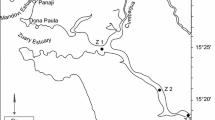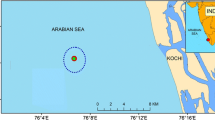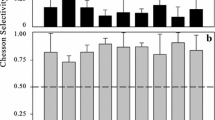Abstract.
Recent studies in temporarily open estuaries of South Africa have shown that phytoplankton biomass is at times low, when compared to the high standing stock of the grazers. In situ grazing rates of the dominant zooplankton species were estimated at the Mpenjati Estuary once during the winter closed phase, in August 1999, and once during the summer open phase, in February 2000. The study aimed at determining what proportion of the energetic demands of the dominant grazers of the estuary is met by the available phytoplankton. Results show that the gut of all species exhibited higher pigment concentrations during the night than during the day, both in winter and summer. Gut pigment contents ranged from 0.27 to 5.38 ng pigm individual–1 in the mysid Gastrosaccus brevifissura, from 0.16 to 1.63 ng pigm individual–1 in the copepod Pseudodiaptomus hessei, from 0.12 to 0.45 ng pigm individual–1 in the copepod Acartia natalensis, and from 0.8 to 5.44 ng pigm individual–1 in the caridean Palaemon sp. [where pigm is the sum of chlorophyll-a (chl-a) and phaeopigments]. During the winter closed phase, gut evacuation rates for G. brevifissura, P. hessei, and A. natalensis were 0.62, 0.42, and 0.46 h–1, respectively. In summer, gut evacuation rates were 0.68, 0.48, and 0.46 h–1 for G. brevifissura, P. hessei, and Palaemon sp., respectively. The rate of gut pigment destruction for G. brevifissura was 99.6% of the total ingested, one of the highest values ever recorded for any crustacean. A gut pigment destruction of 79.0% was measured for Palaemon sp., 95.7% for P. hessei, and 93.8% for A. natalensis. During winter the total grazing impact of the dominant zooplankton species ranged from 5.05 to 22.7 mg chl-a m–2 day–1 and accounted for 34–69% of the available chl-a in the water column. During summer, the grazing impact ranged between 0.45 and 0.65 mg chl-a m–2 day–1, accounting for 17–41% of the available chl-a in the water column. This shows that the dominant zooplankton species of the Mpenjati have a very high grazing impact on algal cells. At times this may exceed 100% of the available phytoplankton production, suggesting that the zooplankton community may often resort to other food sources to meet all its energetic demands.
Similar content being viewed by others
Author information
Authors and Affiliations
Additional information
Electronic Publication
Rights and permissions
About this article
Cite this article
Kibirige, .I., Perissinotto, .R. In situ feeding rates and grazing impact of zooplankton in a South African temporarily open estuary. Marine Biology 142, 357–367 (2003). https://doi.org/10.1007/s00227-002-0963-x
Received:
Accepted:
Issue Date:
DOI: https://doi.org/10.1007/s00227-002-0963-x




